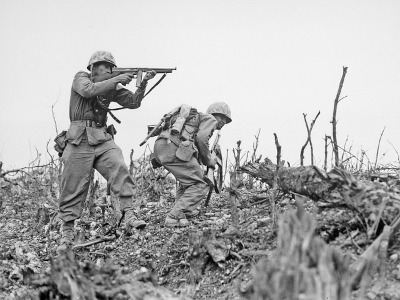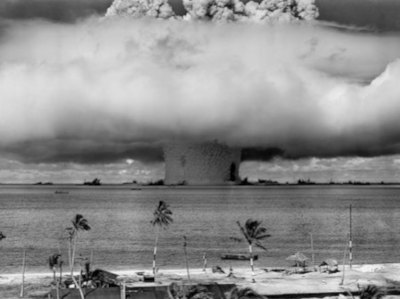The beginning of World War II
Before World War II, Europe was still recovering from the devastation caused by World War I. The unresolved issues from the previous conflict, such as political and economic instability in Germany and resentment over the harsh terms of the Versailles Treaty, played a significant role in the rise of Adolf Hitler and the National Socialist German Workers’ Party, abbreviated as NSDAP. Hitler, who believed in the superiority of the German race, quickly consolidated power after becoming Chancellor of Germany in 1933. He began secretly rearming Germany and formed alliances with Italy and Japan.
In 1939, Hitler and Stalin signed a pact that worried Britain and France. Hitler wanted to invade Poland, and the pact with Stalin meant he wouldn’t have to fight on two fronts. Hitler invaded Poland on September 1, 1939. Two days later, France and Britain declared war on Germany, starting World War II.
Simultaneously, Soviet troops invaded Poland from the east, and Poland quickly fell. Germany and the Soviet Union divided control over Poland. Stalin’s forces then occupied the Baltic States and defeated Finland. In the months following the invasion of Poland, there was little action in the west, leading to talk in the news media of a “phony war”. However, there were intense battles at sea between the British and German navies.

World War II in the West (1940–1942)
During World War II in the West from 1940 to 1941, Germany invaded Norway and Denmark and then swept through Belgium and The Netherlands using a tactic called “blitzkrieg.” They broke through the Maginot Line, a defensive barrier built after World War I, and the British Expeditionary Force was evacuated from Dunkirk. France was on the verge of collapse, and Italy formed an alliance with Germany and declared war against France and Britain. Germany entered Paris, and France was divided into two zones.
Hitler then focused on Britain, which had the advantage of being separated from the continent by the English Channel. To prepare for a sea invasion called Operation Sea Lion, German planes bombed Britain a lot from September 1940 to May 1941. This was known as the Blitz and included nighttime attacks on London and other important places that caused a lot of civilian deaths and damage. The Royal Air Force (RAF) eventually beat the German Air Force (Luftwaffe) in the Battle of Britain, so Hitler decided to delay his invasion plans. Britain was struggling to defend itself, so Prime Minister Winston Churchill started getting help from the U.S. through the Lend-Lease Act, which was passed by Congress in early 1941.
Hitler also wanted to invade the Soviet Union to get more land for the German people. He ordered an invasion called Operation Barbarossa. The Germans were able to get close to Moscow because they surprised the Soviets. But the Soviets fought back, and the Germans had to stop because of the cold weather.
World War II in the Pacific (1941–1943)
During World War II, Japan was aggressively expanding its war with China and taking over European colonies in the Far East. Then the United States was drawn into the conflict because it was the only nation capable of stopping the Japanese aggression. In a surprise attack on December 7, 1941, Japanese aircraft bombed the U.S. naval base at Pearl Harbor, resulting in the deaths of over 2,300 American troops. This attack led Congress to declare war on Japan on December 8. Germany and the other Axis powers also declared war on the United States.
After a series of Japanese victories, the U.S. Pacific Fleet achieved a significant victory at the Battle of Midway in June 1942, which marked a turning point in the war. The Allies also had success against Japanese forces on Guadalcanal, one of the Solomon Islands, from August 1942 to February 1943. These victories helped shift the balance of power in the Pacific. In mid-1943, Allied naval forces launched a counterattack against Japan, using a strategy of capturing key Japanese-held islands through amphibious assaults. This strategy, known as “island-hopping,” proved successful and brought the Allies closer to their ultimate goal of invading mainland Japan.
The end of World War II (1943–1945)
During World War II, from 1943 to 1945, the Allies made significant progress towards victory. In North Africa, British and American forces defeated the Italians and Germans. They then invaded Sicily and Italy, leading to the fall of Mussolini’s government in July 1943. However, fighting against the Germans in Italy continued until 1945.
On the Eastern Front, the Soviets launched a counteroffensive in November 1942, ending the Battle of Stalingrad. Harsh winter conditions and limited supplies caused the German troops to surrender on January 31, 1943.
On June 6, 1944, known as “D-Day,” the Allies launched a massive invasion of Europe. They landed 156,000 soldiers from Britain, Canada, and the United States on the beaches of Normandy, France. In response, Hitler concentrated his remaining forces in Western Europe, leading to Germany’s defeat in the east. Soviet troops progressed into Poland, Czechoslovakia, Hungary, and Romania. Meanwhile, Hitler attempted to push back the Americans and British in the Battle of the Bulge, which was the last major German offensive of the war, taking place from December 1944 to January 1945.
In February 1945, the Allies conducted an intense aerial bombardment before launching a land invasion of Germany. By the time Germany formally surrendered on May 8, Soviet forces had occupied a significant portion of the country. While Hitler had already died by suicide on April 30 in his bunker in Berlin,
World War II ended in 1945 after discussions at the Potsdam Conference. The conference involved Presidents Truman, Churchill, and Stalin, who talked about the ongoing war with Japan and the peace settlement with Germany. Germany would be divided into four occupation zones controlled by the Soviet Union, Britain, the United States, and France. Churchill and Truman agreed to Stalin’s plans for Eastern Europe because they needed Soviet cooperation in the war against Japan.
Due to heavy casualties in battles at Iwo Jima and Okinawa, Truman authorized the use of the atomic bomb. The bomb was developed in a secret operation called The Manhattan Project and was dropped on Hiroshima and Nagasaki on August 6, 1945. After this, Japan agreed to the terms of the Potsdam Declaration on August 15, 1945. On September 2, 1945, General MacArthur accepted Japan’s surrender on the USS Missouri in Tokyo Bay.

The results of World War II
The Second World War proved to be the most fatal international conflict in history, resulting in the loss of 60 to 80 million lives. Among these casualties were 6 million Jews who tragically died at the hands of the Nazis during the Holocaust. The civilian population accounted for an estimated 50–55 million deaths, while military personnel constituted 21–25 million of the lives lost during the war. Additionally, countless individuals suffered injuries, and many more were displaced from their homes and lost their possessions.
The aftermath of the war left a lasting impact, including the spread of communism from the Soviet Union into Eastern Europe as well as its eventual triumph in China. Furthermore, there was a significant global power shift from Europe to two rival superpowers, namely the United States and the Soviet Union, which would soon engage in a tense confrontation known as the Cold War.

Sources:
https://www.history.com/topics/world-war-ii/world-war-ii-history
https://www.nationalww2museum.org/war/articles/atomic-bomb-hiroshima
